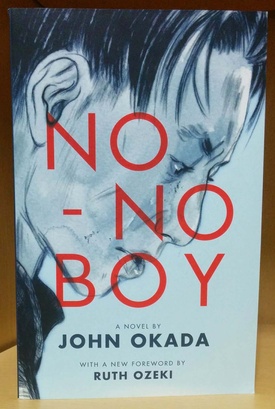The protagonist's suffering depicted on the cover
"No-No Boy," which drew no attention when it was first published, was republished in 1976. Since then, it has been read by many people, and the publisher, University of Washington Press, has published 13 editions and a total of more than 100,000 copies. During this time, it has always had the same cover and the same content, but two years ago, a new edition was released with a new preface and a new cover.
At first glance, the cover illustrations by Bob Onodera are unclear, but on closer inspection they appear to be of a human face with a small American flag in one eye and a rising sun flag in the other, which can be inferred to be the eyes of Ichiro, the protagonist of the novel.
The red letters "NO-NO BOY" are in an army stencil font used on American tanks, etc., which also suggests the content.
The cover of the new edition was designed by Julian Tamaki, an illustrator and caricature artist from Toronto. The profile of a young man, presumably the protagonist Ichiro, is drawn with a somewhat rough, powerful brushstroke against a light blue background. It reminds me of the cover of the first edition in 1957, drawn by M. Kuwata, in which the protagonist was depicted with only his head covering his face with both clenched fists.
In the new version, his straight black hair hangs over the sides of his forehead, and his eyes are wide open, as if expressing anguish or confusion, but it is unclear where he is looking. To a Japanese eye, his eyes and hairstyle make him look more like a Chinese or Korean man than a Japanese person. But it is, of course, Ichiro, and his facial expression reveals what is going on inside him.
The title "NO-NO BOY" is placed in the center, overlapping the profile, and was designed by Thomas Eykemans. The color red seems to symbolize the rising sun of Japan.
The new edition still features a preface by Lawson Inada and an afterword by Frank Chin at the beginning and end of the novel, but also includes a new preface by Japanese-American woman writer Ruth Ozeki, who is one generation younger than Inada and the other Asian-Americans who republished "No-No Boy."
Suddenly, John Okada's signature appears
At first glance, the new edition seems to be exactly the same as the previous one, except for the addition of Ozeki's preface, but there is one slight difference, which is in some sense very significant and has been the subject of criticism.
The novel "No-No Boy" is a story that has Ichiro as the main character, set mainly in Seattle after the war, and consists of 11 chapters. However, it also has a "Preface." It is a 5-page (in the case of the reprint edition) "prologue" or "preface to the story" that is not directly related to the story. In the Japanese version, it is translated as "the beginning of the story."
The opening line translates to, "It was December 7, 1941, when Japanese bombs fell on Pearl Harbor." After this, the book goes on to tell a number of short stories about what happened, or what could have happened, to Japanese and Japanese-Americans on the West Coast and those around them after the outbreak of war between Japan and the United States.
The book concludes with a conversation between a white lieutenant and a Japanese-American soldier whose family had been interned in an internment camp on a plane returning to Guam from a reconnaissance flight to the Japanese mainland during the war. The soldier says that even though his family had been interned, he had a reason for joining the army and fighting. After this, the book turns to the next page and begins the first chapter, as it did in both the original and reprint editions.
Criticized as destroying the artistic value of the work
However, in the new edition, the title "John Okada" appears at the end of the "Preface." This must have been added by the editor. It can also be interpreted as an attempt to convey to the reader that the Japanese-American soldier who appears in the preface is modeled after Okada himself, and that Okada is speaking as a soldier.
Indeed, Okada was a second-generation Japanese-American who volunteered for the military and served in the Pacific theater as a member of the MIS (Military Intelligence Service) during the war. From this perspective, he may have thought of soldiers as if they were his alter-ego and so added his signature.
We will introduce Okada's background at some point, but in the prologue the soldier says that his family was in an internment camp in Wyoming, while in reality Okada's family was in the Minidoka internment camp in Idaho during the war.
Frank Abe, a Seattle resident who has been researching John Okada and No-No Boy for many years, criticizes the fact that the author signed the preface "John Okada" even though he did not write it himself, and that the preface is structured as if it were Okada's own narration, pointing out that many scholars have misread the preface as a projection of Okada himself, saying the following:
"The signature interrupts the dream world constructed by Okada's fiction and destroys his artistic intent.... The preface is part of the fiction, not an autobiography. Okada's signature is an eyesore, a misleading extra, and a hindrance to the story. It should be removed from any future reprints."
The Okada family also denies having signed the document.
It is unclear why this happened, but it would be good to see a correction, as new readers would likely not notice. It would be a big problem if it turned out differently from the author's intention.
(Titles omitted)
© 2016 Ryusuke Kawai







